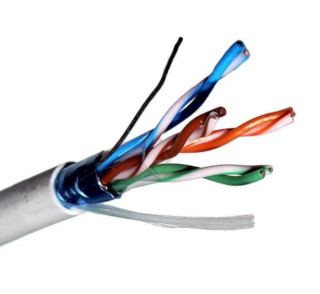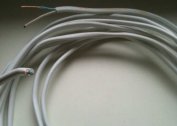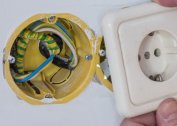Often, consumers who have not received special knowledge in electrical engineering, are faced with laying an electrical network or repairing devices. Household conductors are similar in external characteristics and marking, so it is not easy for users to determine how the cable differs from a wire or cord according to GOST 22483-2012 and TU of manufacturers. You should understand the terminology and get reliable information.
The difference between cable and wire
Cable - a plastic or rubber trunk, placing several insulated conductors inside. Conductors are combined into a single system for ease of installation and operation, protection from external influences. A special cable is easily distinguished by the presence of an armored casing that prevents damage during mechanical action.
A wire is a multi-core or single-core carrier equipped with light tubular insulation or represented by a hollow metal rod with a core cross section of 1.5 mm or more.
The differences between cables and wires are in the number of cores, type of insulation, marking and purpose. Due to the double insulation of current-carrying conductors, the cable transmits high currents and voltage relative to the wire. The difference is hundreds of kilovolts in favor of the cable.
Outer shell
According to GOST 15845-80, a wire is one conductor, a cable is two or more insulated cores combined in additional insulation. If there is no protective sheath on two or more metal rods, by classification it is a wire.
Explanation of Values
 Cable and wire markings are distinguished by letters and numbers.
Cable and wire markings are distinguished by letters and numbers.
Wire names contain the following values:
- the letter “A” in front indicates that it is an aluminum wire;
- "P" - a copper wire;
- "PP" - 2 or 3 flat copper conductors;
- the following values: “P” - polyethylene insulation, “P” - rubber, “B” - vinyl, “L” - cotton braid;
- “N” - additional protection by non-combustible nairite, “B” - vinyl;
- "G" - the letter makes up the difference in the marking, thanks to the flexible current-carrying core;
- "TO" - antiseptic coating.
The numbers in the code indicate the cross-section of the wires.
When marking cables with GOST, the following procedure is established:
- Type of core. "A" - aluminum, the absence of letters - copper.
- Destination “K” - control, “KG” - with increased flexibility.
- Protection. “P” is polyethylene, “B” is vinyl, “P” is rubber, “NG” is non-combustible, and “F” is a fluoron shell.
- Reservation or exterior coating. “A” is aluminum, “C” is lead, “P” is polymer, “B” is vinyl, “P” is rubber, “O” is coating of all phases, and “Pv” is vulcanized plastic.
- Protection. “B” - anti-corrosion armor, “Bn” - non-combustible armor, “2g” - double PVC tape, “Shv” - vinyl hose, “Shp” - polymer hose, “Shp” - self-extinguishing polymer hose.
Scope of use
Reliable protection against mechanical and aggressive action, extended service life, rated voltage are the main features of the cable that should be distinguished from the wire during installation in special conditions. Powerful isolated systems are suitable for laying the power grid under water, underground, in mines, areas of increased fire hazard, and corrosive activity.
According to the PUE (electrical installation rules), the cable is divided into 5 categories:
- Power designed to transmit electricity, stacked stationary or when connecting mobile consumers.
- Mounting conductors are used for inter-instrument installation of devices. They cope well with elevated temperatures and a voltage of 500 V.
- Communication devices are found in alarm systems and wired communication.
- The control lines are well recommended when connecting control and lighting circuits in electrical equipment with a voltage of 600 V.
- Radio frequency and optical media transmit energy and signals at specified radio frequencies or in the optical range.
According to the field of application, the wires are classified into assembly, power, installation groups. The former are used for flexible or fixed wiring in switchboards, the manufacture of radio and electronic equipment. Power options are part of the electrical network, installation wires are applicable when connecting installations, power transmission systems inside, outside buildings.
- For stationary installation in enclosed spaces, wires are suitable - PUGNP, PUNP, APUNP, PVA.
- Installation and assembly products - PV-1, PV-3, APV, MKESH are laid in pipes, building voids, cable trays and under the plaster.
- In places requiring increased heat resistance, PNSV wires are applicable.
- SIP-2, SIP-3, SIP-4 are suitable for overhead lines
- Weak communication - PRPPM, TPPep, TRP.
The classification of electrical conductors is described in detail in ISO 11801 2002.
Life time
The average cable service life is 30 years, wires - from 6 to 15 years. The duration of operation is due to the presence / absence of two or more insulation, an armored shell.
The difference between the cable and the cord
 By definition, cords are flexible wires, including several elastic cores - interwoven wires, insulated with a non-metallic sheath. Products are intended for mobile connection. The difference between the cords is the number of cores: multi-core and two-core products are distinguished, the more threads in the core per unit section, the more flexible the conductor. There are flexible conductors with increased ductility used to create cords.
By definition, cords are flexible wires, including several elastic cores - interwoven wires, insulated with a non-metallic sheath. Products are intended for mobile connection. The difference between the cords is the number of cores: multi-core and two-core products are distinguished, the more threads in the core per unit section, the more flexible the conductor. There are flexible conductors with increased ductility used to create cords.
The flat shape and the minimum cross-section of conductors (1.5 mm2), the use in household wiring are the main indicators that allow you to determine how cords differ from cables and wires. Stranded options are more common, but for electrical appliances that do not require special grounding, two-core cords are quite suitable.
Insulation
Flexible cord cores are coated with polymer insulation and enclosed in one protective casing of soft plastic or rubber.
The power cable is formed by several wires protected by general insulation (PVC, rubber, plastic). Depending on the application, many manufacturers seek to equip the cable with reinforced protective covers, and the wire or cord is hidden under a light sheath.
Only the cable can have additional armor made of lead, aluminum or steel wire / tape indicated on the marking.
Marking
Depending on the purpose and type of insulation in electrical engineering, the following cable markings are found:
- Power options in PVC insulation - NYM, AVVG, VVG.
- Flexible conductors in a rubber casing - KG.
- Control cables - KVVG.
- Power armored products - AVBShv, VBbshvng.
- Information and radio frequency - FTP, UTP, RG, SAT, RK, KVK-V, KVK-P.
- Fire, signaling products: KPSng, KPSENg, KSVV, KSPV, KTsPEP.
- Heat-resistant - RKGM.
Among the common brands of cords are: ШВП, ШВВП, ШТЛП. The first option is suitable for connecting electronic equipment, apartment lamps and climatic equipment (fans, ionizers), under the condition of light mechanical deformations.
ШВВП - stranded cord with copper stranded cores insulated with PVC compound. Vinyl sheath prevents the spread of fire when ignited.
SHTLP - telephone conductor. The cord is linear, contains copper stranded cores in a plastic film with PVC insulation.
Conditions of use
The softness and flexibility of the cord determines the widespread use in everyday life, when connecting household appliances. For fixed installation, monolithic cables are preferred (power, control, control and communications, radio frequency).
Life time
Cable service life depends on technical specifications and operating conditions. For example, power-type products have been used for 30 years at a temperature of −50 ... + 50 ° C. When laying in the open air and in trenches, the control cable has been operating for more than 15 years, and 25 years in rooms, tunnels, channels. ShVVP cord under normal conditions will serve a maximum of 6 years.
The constant operating voltage for the cable varies between 25-70 kV and more, for the cord - 380 V.
The choice between cable and wire
The choice between cable, cord and wire depends on the operating conditions and system specifications. For example, it is unprofitable to purchase a cable for connections with low power, it is better to give preference to 2 wires woven together. Knowing the differences between the electric carriers increases the likelihood of the rational use of material and protection systems, ensuring the safety of the electrical system.









